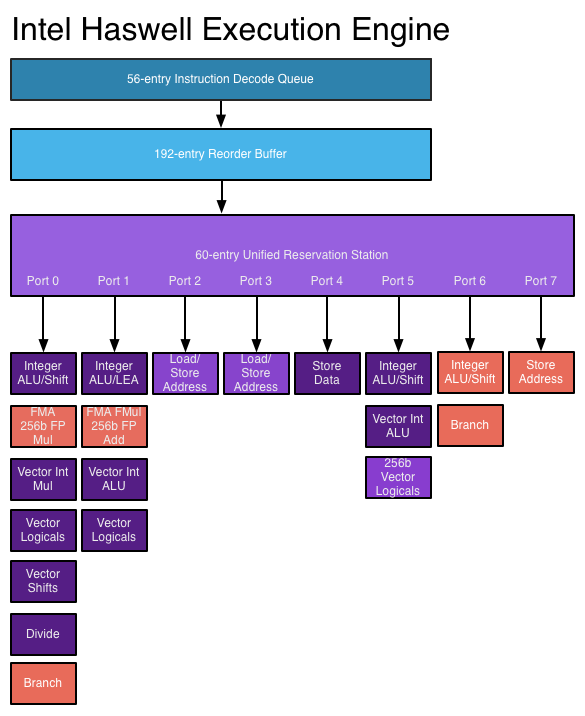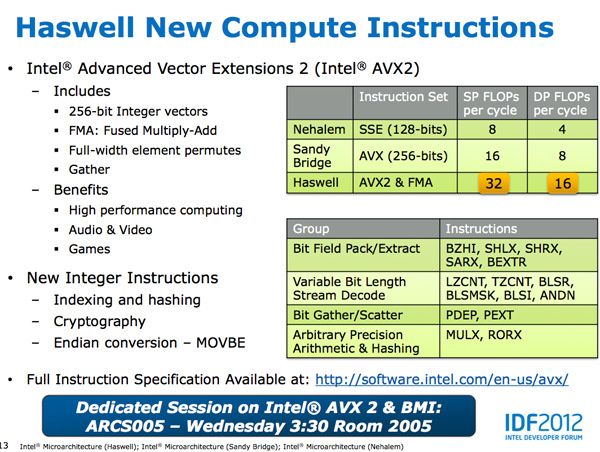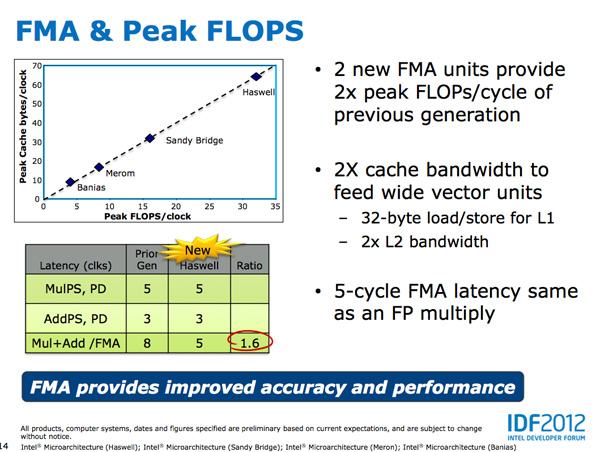Intel's Haswell Architecture Analyzed: Building a New PC and a New Intel
by Anand Lal Shimpi on October 5, 2012 2:45 AM ESTHaswell's Wide Execution Engine
Conroe introduced the six execution ports that we've seen used all the way up to Ivy Bridge. Sandy Bridge saw significant changes to the execution engine to enable 256-bit AVX operations but without increasing the back end width. Haswell does a lot here.
Just as before, I put together a few diagrams that highlight the major differences throughout the past three generations for the execution engine.

The reorder buffer is one giant tracking structure for all of the micro-ops that are in various stages of execution. The size of this buffer is directly impacted by the accuracy of the branch predictor as that will determine how many instructions can be kept in flight at a given time.
The reservation station holds micro-ops as they wait for the data they need to begin execution. Both of these structures grow by low double-digit percentages in Haswell.
Simply being able to pick from more instructions to execute in parallel is one thing, we haven't seen an increase in the number of parallel execution ports since Conroe. Haswell changes that.
From Conroe to Ivy Bridge, Intel's Core micro-architecture has supported the execution of up to six micro-ops in parallel. While there are more than six execution units in the system, there are only six ports to stacks of execution units. Three ports are used for memory operations (loads/stores) while three are on math duty. Over the years Intel has added additional types and widths of execution units (e.g. Sandy Bridge added 256-bit AVX operations) but it hasn't strayed from the 6 port architecture.
Haswell finally adds two more execution ports, one for integer math and branches (port 6) and one for store address calculation (port 7). Including both additional compute and memory hardware is a balanced decision on Intel's part.
The extra ALU and port does one of two things: either improve performance for integer heavy code, or allow integer work to continue while FP math occupies ports 0 and 1. Remember that Haswell, like its predecessors, is an SMT design meaning each core will see instructions from up to two threads at the same time. Although a single app is unlikely to mix heavy vector FP and integer code, it's quite possible that two applications running at the same time may produce such varied instructions. Having more integer ALUs is never a bad thing.
Also using port 6 is another unit that can handle x86 branch instructions. Branch heavy code can now enjoy two independent branch units, or if port 0 is occupied with other math the machine can still execute branches on port 6. Haswell moved the original Core branch unit from port 5 over to port 0, the most capable port in the system, so a branch unit on a lightly populated port makes helps ensure there's no performance regression as a result of the change.
Sandy Bridge made ports 2 & 3 equal class citizens, with both capable of being used for load or store address calculation. In the past you could only do loads on port 2 and store addresses on port 3. Sandy Bridge's flexibility did a lot for load heavy code, which is quite common. Haswell's dedicated store address port should help in mixed workloads with lots of loads and stores.
The other major addition to the execution engine is support for Intel's AVX2 instructions, including FMA (Fused Multiply-Add). Ports 0 & 1 now include newly designed 256-bit FMA units. As each FMA operation is effectively two floating point operations, these two units double the peak floating point throughput of Haswell compared to Sandy/Ivy Bridge. A side effect of the FMA units is that you now get two ports worth of FP multiply units, which can be a big boon to legacy FP code.
Fused Multiply-Add operations are incredibly handy in all sorts of media processing and 3D work. Rather than having to independently multiply and add values, being able to execute both in tandem via a single execution port increases the effective execution width of the machine. Note that a single FMA operation takes 5 cycles in Haswell, which is the same latency as a FP multiply from Sandy/Ivy Bridge. In the previous generation a floating point multiply+add took 8 cycles, so there's a good latency improvement here as well as the throughput boost from having two FMA units.

Intel focused a lot on adding more execution horsepower in Haswell without creating a power burden for legacy use cases. All of the new units can be shut off when not in use. Furthermore, Intel went in and ensured that this applied to the older execution units as well: in Haswell if you're not doing work, you're not consuming power.












245 Comments
View All Comments
Kepe - Friday, October 5, 2012 - link
Let's see. I think we can agree that the Samsung Galaxy S III was the most important Android phone launch of the summer, so it should get comparable treatment if Anandtech was completely neutral. Let's compare the articles about the SGS III vs. iPhone 5Doing a search on anandtech.com gives us 8 articles/news posts about the SGS III vs. 13 articles/news posts about the iPhone 5.
SGS 3:
Five news stories about product announcements
Performance Preview article
Preview article
Review article
iPhone 5:
Why iPhone 5 isn't launched in 2011 article
Analyzing rumours about iPhone 5 article
New SoC in iPhone 5 article
iPhone 5 Live Blog from the product launch seremony
Three news stories about new features and product announcements
iPhone 5 Hands On article
Lack of simultaneous voice and LTE/EVDO article
Analyzing Geekbench results article
Sunspider Performance Analysis article
Performance Preview article
iPhone 5 Display Thoroughly Analyzed article
+ The upcoming iPhone 5 Review article
+ articles such as "iOS6 Maps Thoroughly Investigated"
Look at the difference. It's quite clear which device gets more coverage. And it's the same thing for older iPhones. Articles such as "Camping out for the new iPhone 3GS".
This is NOT equal treatment of all products. This is why my trust for Anandtech has started to slip. Yes, Anandtech still is the best place for reviews, but one really has to wonder if those reviews still are as neutral and objective as they used to be.
vFunct - Saturday, October 6, 2012 - link
It's an android device. Android devices do not matter. Everyone uses iPhones anyways, They are better. Apple makes better products, including laptops.No need to waste space on Android.
Haugenshero - Saturday, October 6, 2012 - link
Please take your pointless apple fanboy drivel to another site that doesn't care about actual hardware and software and just like shiny things.cjl - Saturday, October 6, 2012 - link
Apple's (iOS) current sales are only 20% of the overall smartphone market share, while Android is over 60%, so if either one of the two is largely irrelevant, it's apple.HisDivineOrder - Sunday, October 7, 2012 - link
Shhhh, icks-nay on the facts-nay.You might cause a fanboy's head to explode near one of those inconveniently placed explosive barrels we walk by in real life.
Just imagine a chain reaction. Caused by an Apple fan's mind being blown. You might take out an entire city block.
Do you want that kind of devastation on your karma? Think different. ;)
vFunct - Sunday, October 7, 2012 - link
The Android market is the cheap giveaways.No one willingly pays money for an Android phone.
Not everyone can afford the premium quality of an Apple product. They will have to settle for an inferior Android devices instead until they can afford higher quality products.
Kepe - Monday, October 8, 2012 - link
Nice trolling there. Now go back under the bridge and stay there =)Old_Fogie_Late_Bloomer - Tuesday, October 9, 2012 - link
"Not everyone can afford the premium quality of an Apple product. They will have to settle for an inferior Android devices instead until they can afford higher quality products."Ha ha ha! Well done, if you're screwing around.
But seriously, if you actually believe that, seek psychiatric help. :-P
Spunjji - Thursday, October 18, 2012 - link
Hahahahahahahahahahahahahahahahahahahahahasolipsism - Tuesday, October 9, 2012 - link
And how many of the 20% is on one phone? Let me know when you figure out how to cover every single Androd-based device that hits the market in a given year.